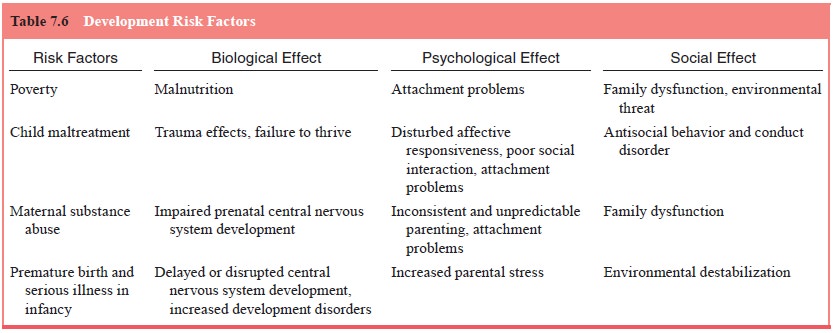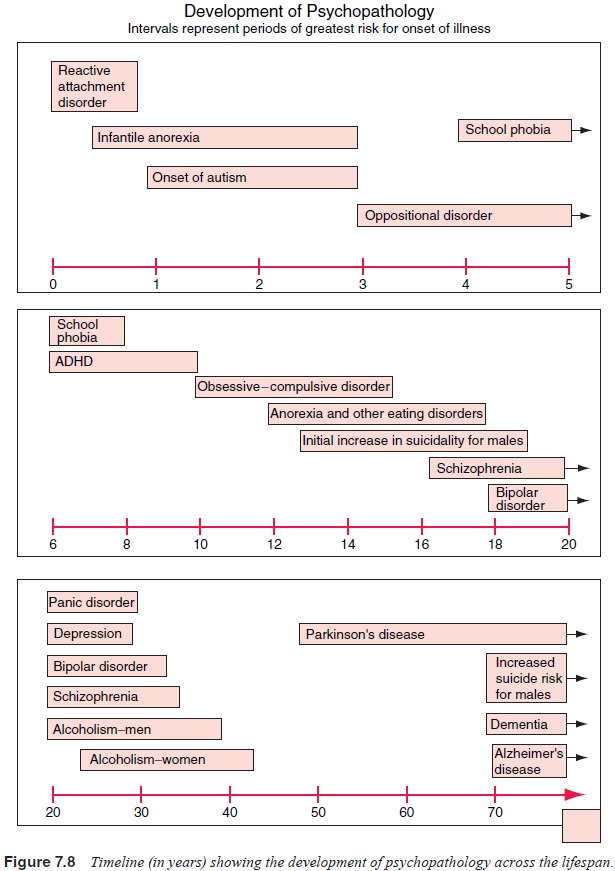Chapter: Essentials of Psychiatry: A Psychiatric Perspective on Human Development
Developmental Psychopathology
Developmental Psychopathology
Risk and Protective Factors
The risk and protective factor model is a paradigm that facilitates the understanding of developmental deviations. It can be applied at any stage of development. Risk factors have been divided into three large categories: those at the level of the individual, the family and the community
The first category of risk factors is defined at
the level of the individual. Both physical and emotional considerations are
relevant. Examples include atypical genetic polymorphisms, defi-cits in
perception and high levels of generalized anxiety. Variable possibilities for
adaptation exist, but for a trait or condition to be considered a risk factor
there must be a demonstrated increase in the probability of subsequent
emotional or behavioral disorder associated with the factor.
The second category of risk factors is
conceptualized at the level of the family. One of the classic examples of a
familial risk factor is a parent with a serious mental illness. It is difficult
to de-fine the mechanism by which this risk is transmitted. Each parent
provides exactly one-half of the genome of the child. However, par-ents are
also in a powerful position to shape the early environment of their children.
The full range of family risk factors is quite broad, and extends beyond the influence
of single individuals within the family to include the impact of family
dynamics which influence the development of the child. For example, a
scapegoated child in a family environment that tolerates overt child
maltreatment is at particularly high risk for the development of
psychopathology.
The third category of risk factors is defined at
the level of the community. Discrimination based on ethnic or racial status
falls into this group of risk factors, as does social disadvantage. Although
there is little controversy regarding the negative consequences of
discrimination and poverty, the quantification of this risk has been
problematic. Community risk factors rarely occur in the absence of individual
and familial risk factors, making it difficult fully to understand their
specific influence. Table 7.6 elucidates some important developmental risk
factors.

One strategy that has been used to determine the overall risk for developmental psychopathology is to add up the specific factors that a child must deal with, creating an adversity index. This has been accomplished for young children (Sameroff, 1986) as well as applied to risk factors occurring later in development (Rutter, 1985a, 1985b). Most individuals can cope with a small number of risk factors, particularly if protective factors are also present. However, under the weight of multiple risk factors, most individuals begin to show signs of disturbance. Sophisticated research designs have been developed to estimate relative contributions (Topolski et al., 1997). Curiously, the quantitative effects of protective factors have been less extensively studied, although investigations into the life course of resilient individuals provide some understanding of these factors (Mrazek and Mrazek, 1987).
Resilient children represent one of the most
fascinating opportunities to understand the mechanisms by which risk and
protective factors interact. The study of the children of mothers with
schizophrenia or bipolar disorder has been an area of inves-tigation that is of
particular interest to psychiatrists. Perhaps this is because these children
have been perceived to have had both a high risk for the inheritance of genes
that confer poor adap-tive skills and the misfortune of having a parent with impaired
capacities for sensitive responses to their early developmental needs. What is
striking is that some of these children turn out to be productive and happy
adults despite what appear to be over-whelming odds.
In adulthood, resilience depends on the ability to
find, use and internalize social supports. Throughout the life span, maturity
of ego defense is an important characteristic of resilience (Vaillant, 1993).
The use of mature defenses has been associated with health – whether health was
defined as the presence of successful objective life adjustment, the absence of
psychopathology, or the achievement of subjective self-satisfaction. The number
of risk and protective factors appears to be more significant than the
specificity of stressors.
A timeline of the development of psychopathology
during the course of the lifespan is presented in Figure 7.8.

Related Topics